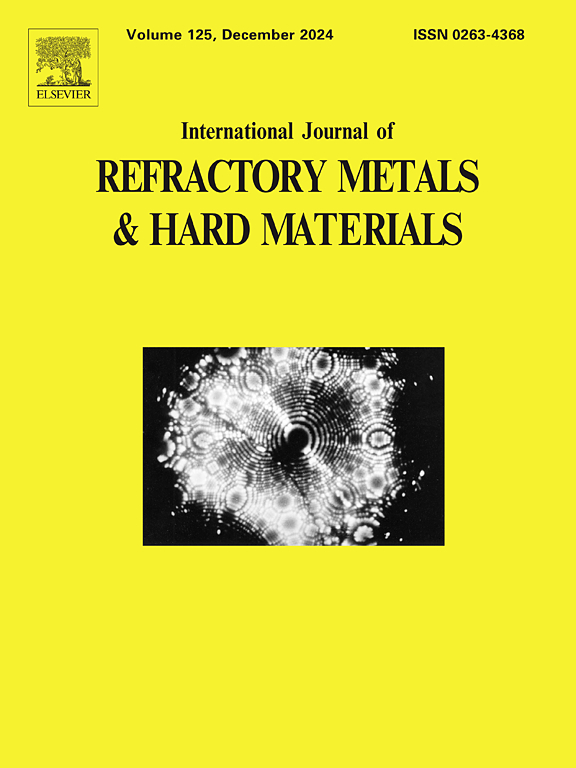WC-Co合金弹芯侵彻自锐特性研究
IF 4.2
2区 材料科学
Q2 MATERIALS SCIENCE, MULTIDISCIPLINARY
International Journal of Refractory Metals & Hard Materials
Pub Date : 2025-03-21
DOI:10.1016/j.ijrmhm.2025.107150
引用次数: 0
摘要
提高钨合金长杆弹侵彻能力的方法一直是众多研究者的研究课题,在侵彻过程中产生弹芯头部的“自锐”是一种有效的解决方案。之前的研究发现,88 wt% WC-Co(钨钴硬质合金)合金在高速侵彻试验中形成的弹孔比常规93 W合金更小。一般认为,具有自锐特性的穿孔弹穿透后孔径变小。本研究选取94% WC-Co合金和88% WC-Co合金进行对比研究。对两种合金进行了准静态、动态(SHPB)压缩试验和高速侵彻试验。利用扫描电子显微镜对试样和残余弹芯进行了系统分析。结果表明:两种合金试样均被压碎,88 wt% WC-Co合金的准静态抗压屈服强度为3.42 GPa;随着破裂角(顶面与断面夹角)的增大,断裂模式逐渐由穿晶断裂过渡到沿晶断裂,观察到Co相的润滑特性,SHPB试验后的破裂角基本超过45°。94 wt% WC合金的准静态抗压屈服强度为4.15 GPa,准静态/动态压缩后,试样出现由前向后的纵向裂纹,主要为晶间断裂模式。经过高速侵彻试验,两种合金制成的弹芯在侵彻过程中表现出自锐特性,这是通过材料破碎和Co相润滑实现的。该研究为进一步研究WC-Co合金穿甲弹的自锐特性提供了参考。本文章由计算机程序翻译,如有差异,请以英文原文为准。
Research on the self-sharpening characteristics of WC-Co alloy projectile core during penetration
Numerous researchers are seeking methods to enhance the penetration power of tungsten alloy long-rod projectiles, and generating “self-sharpening” in the head of projectile core during penetration is an effective solution. Previous studies found that 88 wt% WC-Co (tungsten‑cobalt cemented carbides) alloy formed smaller ballistic holes compared to conventional 93 W alloy during high-speed penetration test. It is commonly believed that penetrators with self-sharpening characteristics resulted in smaller hole diameters after penetration. This study selected 94 wt% WC-Co alloy and 88 wt% WC-Co alloy for comparative research. Two alloys were subjected to quasi-static, dynamic (SHPB) compression tests, and high-speed penetration tests. The specimens and residual projectile cores were systematically analyzed using scanning electron microscopy (SEM). The results showed that both alloy specimens were crushed, and the quasi-static compressive yield strength of 88 wt% WC-Co alloy was 3.42 GPa. As the fracture angle (angle between the top surface and the fracture surface) increased, the fracture mode gradually transitioned from transgranular to intergranular fracture, with observations of the lubricating characteristics of Co phase, and the fracture angle after SHPB tests basically exceeded 45°. The quasi-static compressive yield strength of 94 wt% WC alloy was 4.15 GPa, and after quasi-static/dynamic compression, the specimens developed longitudinal cracks from front to back, primarily in an intergranular fracture mode. After high-speed penetration tests, it was observed that the projectile cores made from both alloys demonstrated self-sharpening characteristics during penetration, achieved through material fragmentation and lubrication by Co phase. This study provides reference for further research on the self-sharpening characteristics of WC-Co alloy penetrators.
求助全文
通过发布文献求助,成功后即可免费获取论文全文。
去求助
来源期刊
CiteScore
7.00
自引率
13.90%
发文量
236
审稿时长
35 days
期刊介绍:
The International Journal of Refractory Metals and Hard Materials (IJRMHM) publishes original research articles concerned with all aspects of refractory metals and hard materials. Refractory metals are defined as metals with melting points higher than 1800 °C. These are tungsten, molybdenum, chromium, tantalum, niobium, hafnium, and rhenium, as well as many compounds and alloys based thereupon. Hard materials that are included in the scope of this journal are defined as materials with hardness values higher than 1000 kg/mm2, primarily intended for applications as manufacturing tools or wear resistant components in mechanical systems. Thus they encompass carbides, nitrides and borides of metals, and related compounds. A special focus of this journal is put on the family of hardmetals, which is also known as cemented tungsten carbide, and cermets which are based on titanium carbide and carbonitrides with or without a metal binder. Ceramics and superhard materials including diamond and cubic boron nitride may also be accepted provided the subject material is presented as hard materials as defined above.

 求助内容:
求助内容: 应助结果提醒方式:
应助结果提醒方式:


